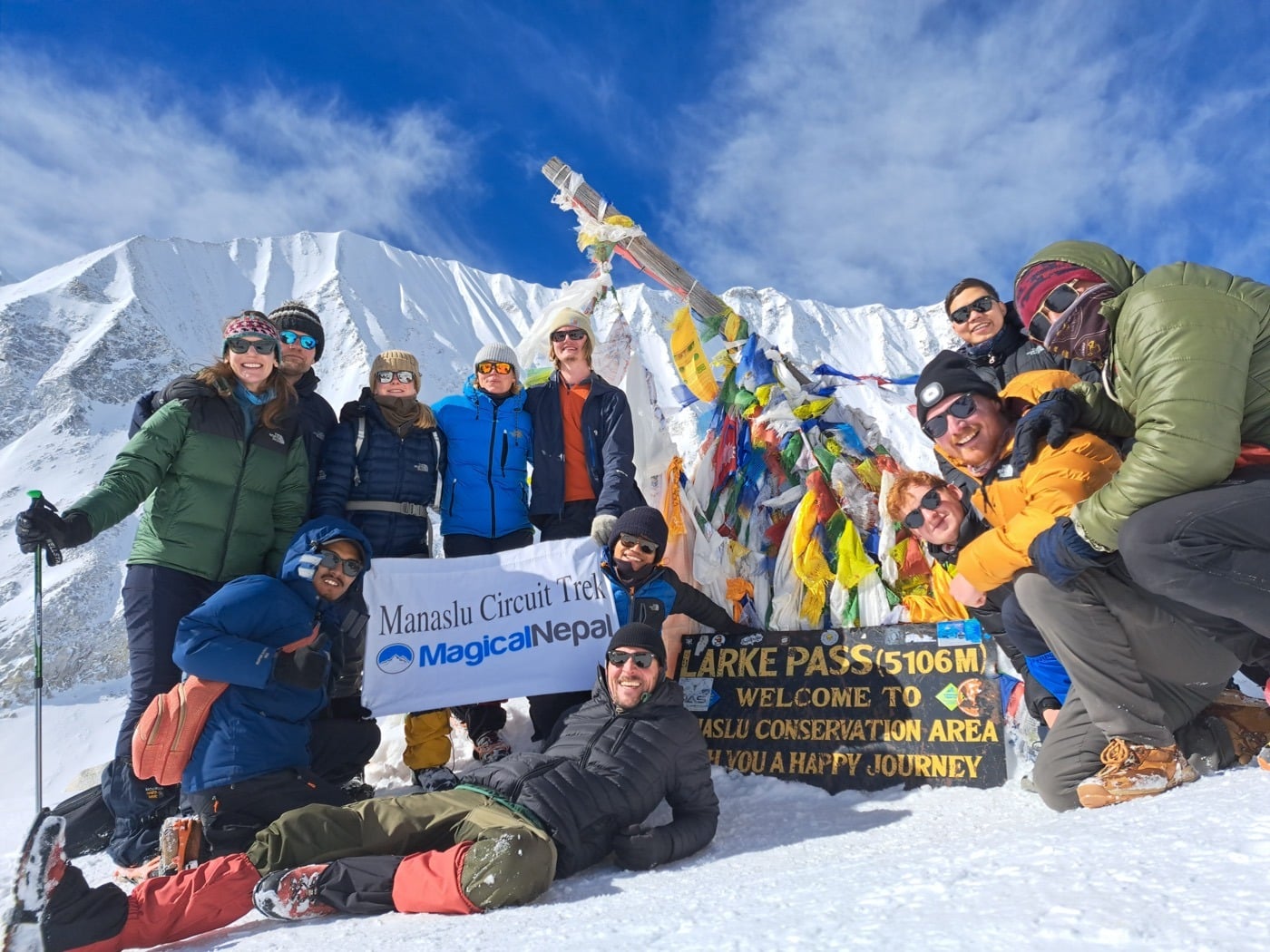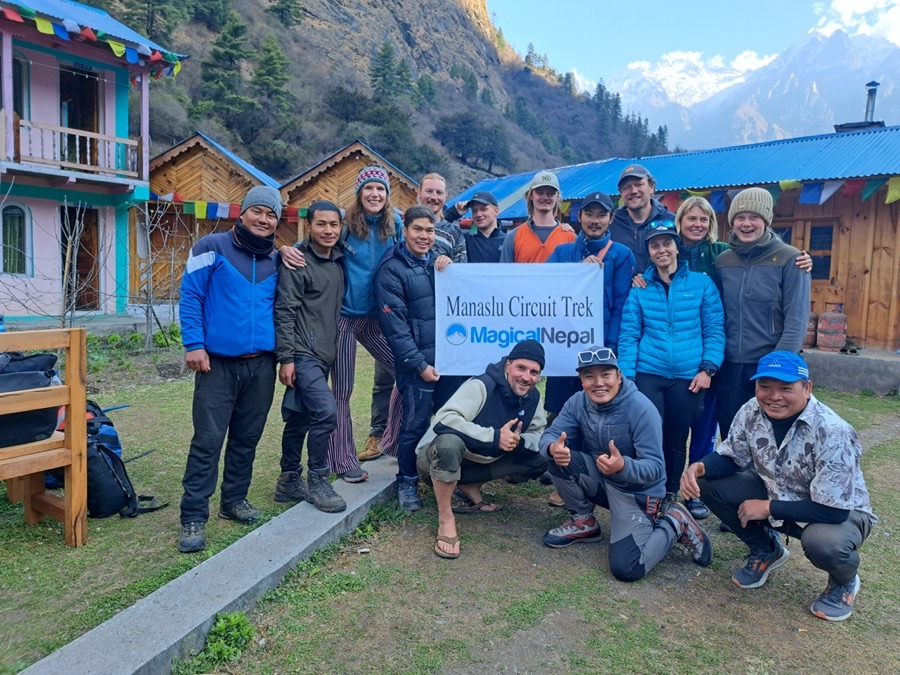Manaslu Circuit Trek
| Starts at: Maccha Khola | Ends at: Besisahar |
| Trek Region: Manaslu | Transport: Public Bus |
| Duration: 13 Days | Trip Grade: Challenging |
| Max Altitude: 5167 m / 16752 ft (Larkya Pass) | Accommodation: Basic teahouses |
The Manaslu Circuit Trek still has a pioneering expedition feel. With only a limited number of trekkers allowed every year into this restricted area, come experience Nepal as it should be seen: in all its roughness, astounding beauty, varieties of landscape and wildlife, ethnic peoples, and rich Nepali and Tibetan cultures. Here life is simple, unpretentious, and often grueling. Much like this trek. Are you ready?
Other Trips in the Manaslu Region:
- Tsum Valley Trek – 11 days
- Manaslu Circuit Tsum Valley Trek – 20 days
Overview of the Manaslu Circuit Trek
Winding your way through the Manaslu Conservation Area, this 13-day trek starts in the hot and humid lowland terraces of rice and millet and through the gorges of the Budhi Gandaki River and works north to its highest point at the Larkya La Pass.
Now you are just a stone’s throw away from the Tibetan border from where many of the locals you will meet on this trek originate.
You are also standing at a height of 5,167 meters / 16,952 feet, most likely on snow and ice, and staring face-to-face with Mount Manaslu. Rising 8,163 meters / 26,781 feet into the heavens, Manaslu is the eighth-highest mountain in the world.
Among the many other 8,000.m giants you find in Nepal, Manaslu is considered the most graceful, as its neighbors, the Annapurnas in the west and Ganesh Himal to the east, will testify.
Not that these mountains are not stunningly charming in their own right. On this trek not only do you see these giants of mountains but the resulting glacial cirque created by them, casting down a stream of glaciers which forms a great amphitheater of ice.
Lowering your eyes from the snowy heavens, encounter the equally as touching natural beauty of the rivers, forests, and flora.
Wildlife is also plentiful in this conservation area. Unique wildlife such as the Tahr (a type of Himalayan goat), Agali (a mountain sheep), Pika (a tiny mountain mammal related to the rabbit), and of course who wouldn’t wish to spot the allusive Snow Leopard or Red Panda.
The local people you will meet on this trek are hardy mountain stock, many having originated from Tibet as is apparent in the Tibetan-like culture of the area.
They live their lives embracing the lifestyle that has remained pretty much the same for generations.
Naturally, the 21st century is creeping and while trekkers enjoy the simplicity of the culture and the ruggedness and remoteness of the landscape, it will change in the not-too-distant future!
Why This Trek? – Highlights to Love
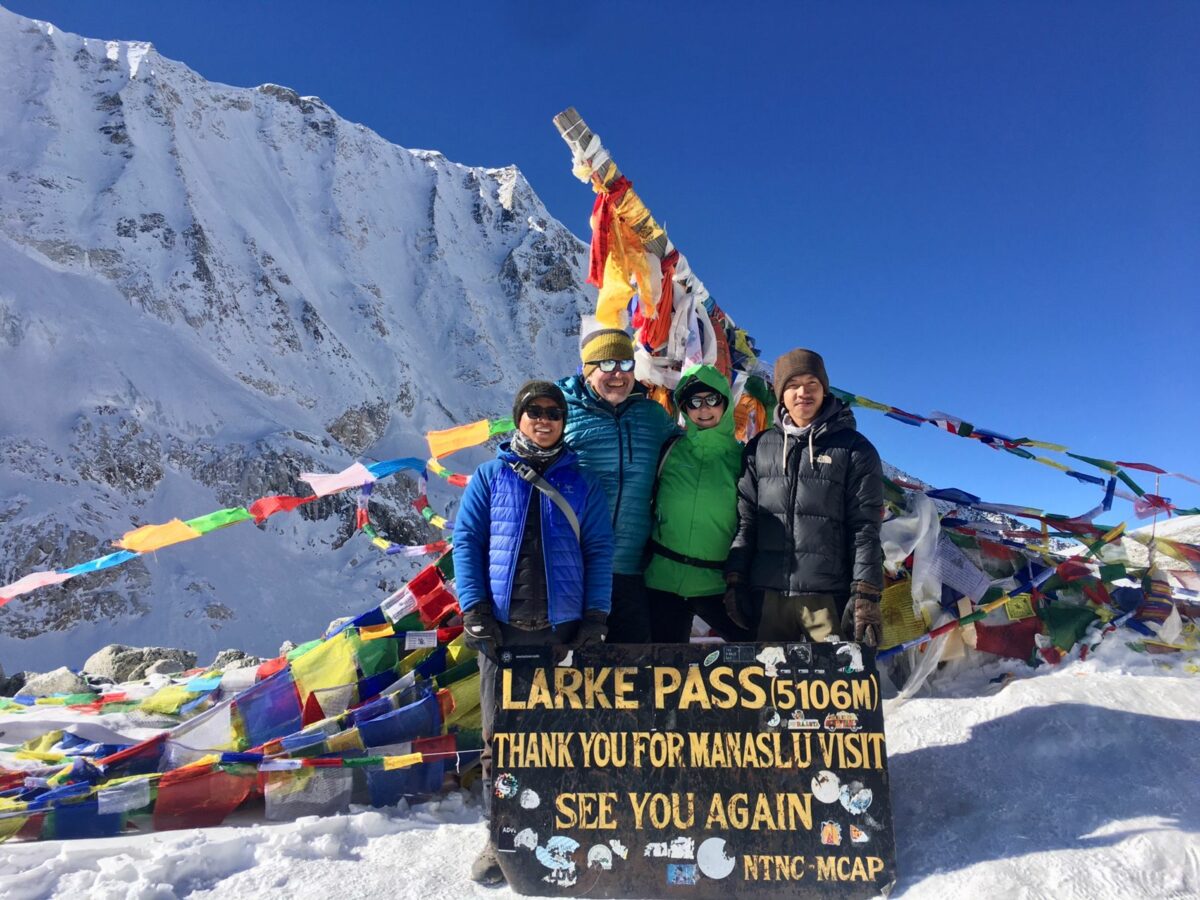
- Needless to say: the high mountains, particularly snow-covered Manaslu!
- The well-preserved Manaslu Conservation Area with its many different forest types and over 2,000 species of plants.
- Testing your limits in reaching 5,106 meters / 16,929 feet to cross the Larkya Pass with its out-of-this-world views.
- Gazing at, yet resisting the temptation to cross into, Tibet. (Save that for another, legal, trip!)
- Experiencing the culture of the region, with its rich Buddhist and Hindu traditions from both Tibetan and Nepali influences.
- Meeting locals ranging from Gurungs from the ancient Gurkha Kingdom, to those whose recent forefathers plied old trade routes.
- Enjoy trekking as it was and should be – a no-frills adventure into the wilderness. Well, perhaps just a little bit of comfort now and again!
- Benefit from the company of our experienced guides and porters who will help you enjoy every moment of your trip with their knowledge, good sense and demeanor, and a great sense of humor.
- Rest assured we strive to leave nothing but footprints behind on this, and all our treks: keeping the Manaslu Conservation Area pristine for future generations of locals and visitors.
A Bit of History About Manaslu Circuit Trek
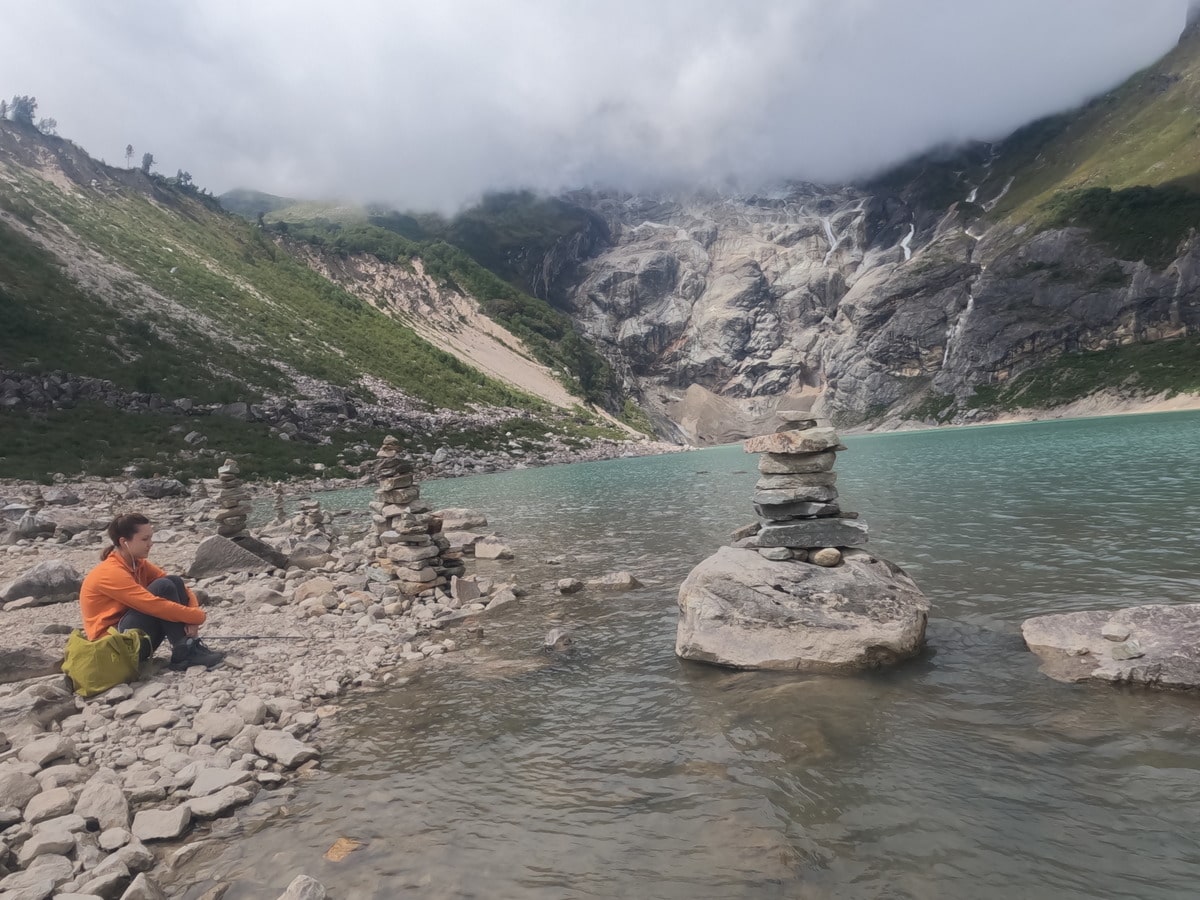
Before looking at what you will see along the Manaslu Circuit trail, it’s good to have a brief look at its history. The Shahs were the last ruling dynasty of Nepal – from 1769 AD to 2008 AD.
They modernized the country and changed the political landscape. This is relevant to Manaslu as this region is where the Shahs set up their ‘kingdom’. Perhaps the most famous, and certainly the most influential of these rulers was Prithvi Narayan Shah. Known as the founder of modern Nepal,
you will notice the road between Kathmandu and Pokhara is named after him, and perhaps you will also notice statues of him in various places throughout the country.
Born in 1723 AD, he left his home in Gorkha (within the Manaslu region) to unify other small kingdoms and finally defeating the three kingdoms of the Kathmandu Valley, unified the whole country into one. Therefore, we can see that this region has played a very important role in the formation of modern-day Nepal.
Diverse Culture
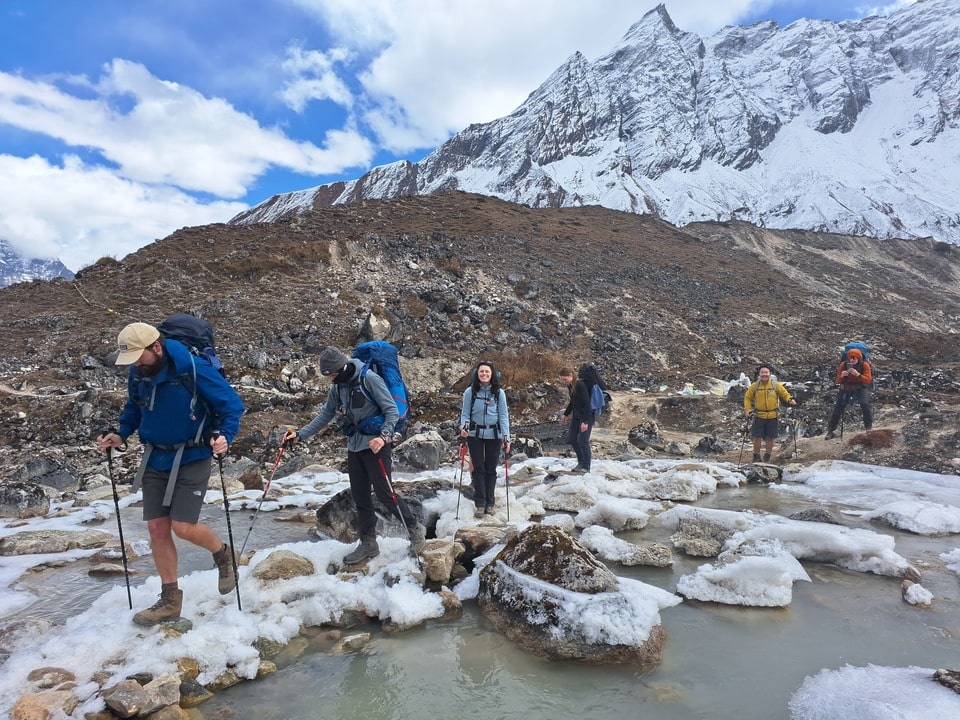
Today the Manaslu region is largely inhabited by people known as Gurungs. Having migrated from Tibet around the 6th century, they left Tibet before the birth of Buddhism there and only took up Buddhist practices much later.
They are very influential in the modern day as it is the Gurungs, also known as Gurkhas, that are active in the Nepal, Indian, and British armies as well as being the majority in the UN Peacekeeping force.
People from the Nubri and Tsum ethnic groups also live in the Manaslu region. Once again, the Nubri people came from Tibet to live in the Nubri Valley (upper Gorkha District).
Traditionally they spoke a Tibeto-Burman language but with only 2,000 or so of this ethnic group living there, a recent study by the University of Hong Kong hopes to preserve the language somewhat.
The other ethnic group is the Tsum who originate from Tibet and are spread over the Tsum Valley where they practice Buddhism and Bon Po, a pre-Buddhism religion.
While on this trek you will notice the Buddhist symbols and objects such as prayer flags, chorten, and small shrines in the teahouses and homes.
There are several monasteries on the route as well, such as at Sama and Samdo villages. Here you can perhaps join monks in their daily ceremonies. If your timing is right, there are several festivals to enjoy.
Local Communities and Cultural Experiences
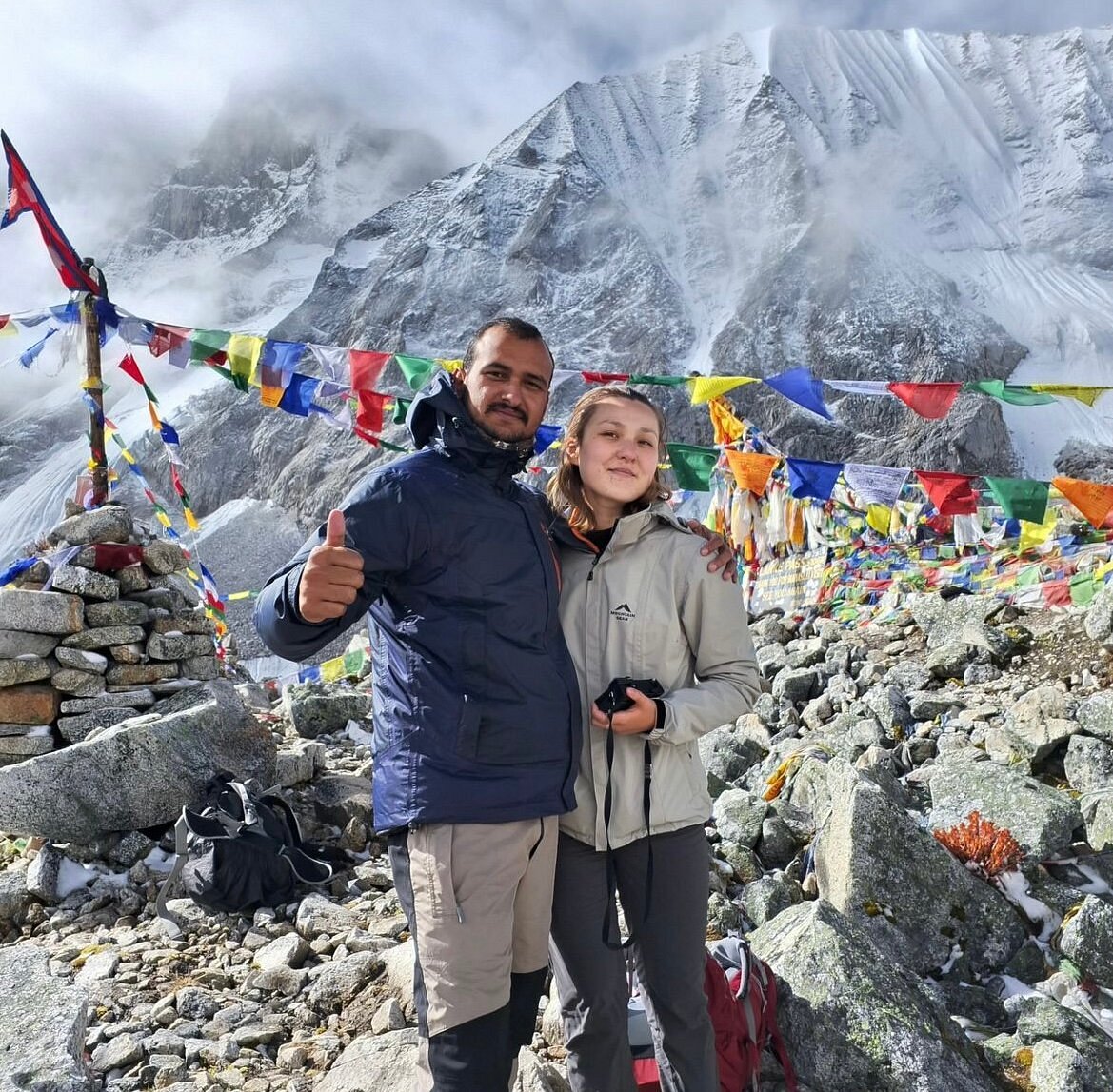
© manaslutreknepal.com
While there are a lot of similarities in the communities you will pass through, there are also differences.
While the Gurungs, Tsums, and Nubris all came from Tibet, they all came from very different periods in history.
Meaning their religious experiences differ somewhat, yet they all come together with a blend of Buddhism, animism, and/ or Bon. They all have different traditional languages yet all live alongside each other in harmony.
In this region, particularly the lower areas, you will also see other groups such as Chettri and Brahmin who practice Hinduism, and Newar who practice a unique Nepal mix of Hinduism and Buddhism.
Every day you will have a chance to interact with people either with a happy smile and nod as you pass them working in the fields, or as you make your way through their settlement.
In the evening you will be able to interact more fully with the owners of the teahouses you stay in. With fewer trekkers coming through, the teahouses are less busy than those on the more established trails, and the owners are less jaded and often more hospitable with their time.
The Geography and Natural Beauty of Manaslu
The Manaslu Circuit Trek takes you from the sub-tropics of the foothills to the trans-Himalayas bordering Tibet. In less than two weeks! From the steamy rice fields to the snow and ice of the high Himalayas, this is quite a journey!
You cover four climate zones happening at different altitudes. Temperate, sub-alpine, alpine, and nival zones, also called tundra. Naturally, the vegetation and wildlife vary within these zones.
People live below the naval level, which in the Himalayas is around 5,000m / 16,404 feet and covered in snow most of the year round.
With the advent of trekking and mountaineering some lodges have been established at over 4,000m / 13,123 ft but for year-round living local inhabitants prefer lower altitudes and often leave the high mountains during the harsh winter months.
As you can imagine, the temperature on this trek varies considerably. It’s important then to choose the right gear and equipment as per the relevant section of this site and dress appropriately.
With these different climates, the natural beauty of the Manaslu Circuit Trek is unsurpassed. Forests of rhododendron and Himalayan pine are fragrant as well as being a cool temperature start to your trek.
The Budhi Gandaki River snakes its way through the lower landscape providing glittering views of its clear waters. Crossing suspension bridges or possibly having to leap across boulders in the river adds a new dimension to ‘river crossing’.
After the lower terrace fields, the agricultural land changes to yak pastures before it vanishes altogether into the harsh and rocky segments further uphill.
It should be pointed out that there may be changes to the trail as this trekking route is in a landslide and landfall-prone area, which mainly happens during the monsoon but can affect the trails for the following months too.
Bio-diverse
Nepal is blessed with a huge number of birds, including migratory and non-species. In the Manaslu area, we can find over 110 species of birds.
Among the 33 species of mammals the most sought-after, and elusive, is the Snow Leopard. Almost as elusive is the extremely cute-looking Red Panda!
Having reddish-brown fur and white-lined ears, muzzle, and ringed tail, these pandas can trace their ancestry back around 25 to 18 million years.
Being only a maximum of 15kg in weight it has been established they are closer to raccoons and skunks than to the giant black and white pandas found in China.
Interestingly, in Nepal, they live mainly in highly restricted areas, which are, due to their location, areas where the local human population practices Buddhism.
With its belief in all lives being sacred, Buddhists do not hunt animals. It is also true that monks in the monasteries in these high-altitude protected areas promote the conservation of all species.
Conservation is key to the future of both the biodiversity of the flora and fauna and the preservation of the culture of this exceptional area.
Environmental Conservation Efforts

The main organization for conservation in Nepal is the National Trust for Nature Conservation (NTNC), along with other organizations such as the World Wildlife Fund (WWF) and UNESCO.
Basic eco-tourism infrastructure was researched and subsequently established in Manaslu in 2001 following the establishment of the Manaslu Conservation Area in December 1998. This was the second conservation area falling under the management of the NTNC.
With an area of 1,663 square km, there are three broad geographical areas within the conservation area: Nubri Valley, Kutang, and the Tsum Valley. These areas provide home to around 9,000 people as well as a host of birds, mammals, butterflies, reptiles, and flora.
Working on the theory that the best way to conserve an area is to involve the local communities, the Trust implements field programs to mobilize locals to take the lead in managing their resources. The overall approach focuses on sustainable natural resource management.
Believing Manaslu has a lot to offer international trekkers, the Trust is positive about local communities taking a role in providing tourism services which will increase their income as well as provide a great experience for trekkers. Local Conservation Area Management Committees (CAMCs) have been enhanced through regular training to ensure responsible, sustainable management of natural resources.
Regular research is done to develop a database on biodiversity and socio-economic conditions in the region through the collection of data to record physical and social changes. This is all helped by the Buddhist belief of not harming any living creature and environmentalists work closely with lamas from local monasteries.
Overall, the objectives of the NTNC in the Manaslu Conservation Area are to conserve and sustainably manage the natural resources and rich cultural heritage, and promote ecotourism to improve the livelihoods of the local people,
We at Magical Nepal believe in these objectives also and encourage our trekking guests to be respectful and mindful when on any of our treks.
Why This Manaslu Circuit Trek
- Aside from Manaslu itself the mountains you will see are Annapurna II 7,937m / 26,040 ft, Himlung Himal 7,126 m / 23,379 feet, Kangguru Himal 6,980 m / 22,902 feet, Dhaulagiri 8,167 m / 26,795ft, Tilicho Peak 8.048 m / 26,406 feet, Ganesh Himal 7,421 m / 24,350 among others!
- The view from the Larkya Pass: as you stand among stupas (cairns) and fluttering prayer flags, you will see a massive glacier wall created by Cheo Himal, Gyaji Kang, Kang Guru, and Himlung Himal. Not to mention Annapurna towering above.
- Visit monasteries: such as at Sama Gaun and meet the resident monks.
- Visit Birendra Tal, a lake that lies only a short hike from Sama Gaon and is a perfect way to spend your acclimatization day.
- Birdwatching: if this is a passion of yours, don’t forget your binoculars as there are over 110 interesting species to spot!
- Bathe in the hot springs on day two of the Maccha Khola to Jagat part of the journey.
- Meet the locals: farmers, yak herders, entrepreneurs, traders, and young school students.
- Search for Himalayan wildlife including the silver-furred Snow Leopard and the Red Panda.
- Each day is unique and different: from the warm lowlands to the cold and icy highlands with forests, rivers, and rocky terrain in between!
The Challenges and Rewards of the Manaslu Circuit Trek
Is This Trek Right for Me?
Despite being only 11 days of actual hiking, this is a challenging trek. It should not be undertaken by those with serious underlying health conditions or by those who are, let’s face it, couch potatoes! Even those experienced in trekking or who have an active lifestyle should prepare well in advance.
Walking for 7 hours at sea level with your vehicle waiting to take you back to your warm accommodation is not the same as walking for 7 hours at high altitudes where the air is thin and the only way to your overnight accommodation is to keep going on foot! And that trekking lodge, while reasonably comfortable, is no luxury accommodation!
That said, if you are up to the challenge, this may be the most memorable trip of your life!
The Challenges
Day one starts with a long road journey. There is the choice of a local bus which will take upwards of 8 hours and leaves between 6 and 7 am. Inexpensive as it is, it’s not the most comfortable way to start your journey.
The alternative is a private jeep. That will take around 7 hours, leaving your hotel around 8 am, and will be much more comfortable. Naturally, it is more expensive. The choice is up to you. Remember you also have to come back on a 7 or 8-hour road journey.
Every day on the trail brings new excitement and new challenges in terms of tired legs, challenging trails to negotiate, high suspension bridges to cross, hot and cold weather to deal with, and changes in altitude.
You will be tired. And yet, the day you cross the Larkya La Pass you will be expected to rise at 3 am to make the crossing before the high winds that roll in in the afternoon.
Food may not be what you are used to; although always hot and plentiful. Bringing your snacks will help.
Aside from aching muscles, the biggest challenge will be the altitude. Drinking plenty of fluids, walking steadily but slowly, and listening to your body, and the guide’s advice, will ensure you have a safe trip. Reading up on altitude-related illnesses before you come will also help you be prepared.
The Rewards
Any trek in the Nepal Himalayas comes with the great reward of a lifetime of memories and photographs!
It comes with the knowledge that you did something amazing that you may never do again. Or perhaps you will return again and again to seek out this awesome experience.
Seeing some of the highest mountains in the world cannot be compared to any other experience. Standing above some of the smaller mountains as you cross the high pass is also something that cannot be compared.
Witnessing other cultures, and cultures that cannot be found even in other parts of the Himalayas. Trading smiles with monks, young children, and old people is something no amount of money can buy.
Comradery with fellow trekkers and your guide is something you should also look forward to. Friendships like that can last a lifetime.
The knowledge that you achieved such a journey does wonders for your self-esteem and may give you a couple of coffees or drinks at the bar!
Does it sound like this trek is for you?
We certainly hope it does because we cannot state enough how wonderful this trek is!
Manaslu Circuit Trek Itinerary
Day 1: Kathmandu to Maccha Khola (Drive)
Maccha Khola – 930 m / 3,051 ft -9 hrs
Day 2: Maccha Khola to Jagat
Jagat – 1,340 m /4,396 ft – 6 hrs
Day 3: Jagat to Deng
Deng – 1,804 m / 5,918 ft – 6 hrs
Day 4: Deng to Namrung
Namrung – 2,630 m / 8,628 ft – 6 hrs
Day 5: Namrung to Lho
Lho – 2,957 m / 9,701 ft – 4 hrs
Day 6: Lho to Sama Gaun
Sama Gaun – 3.530 m / 11,581 ft – 4 hrs
Day 7: Acclimatization Day (Day Trip to Manaslu Base Camp or Pungyen Gompa)
Sama Gaun – 4,400m / 14,435 ft – 7 hrs
Day 8: Sama Gaun to Samdo
Samdo – 3,865 m / 12,680 ft – 3 hrs
Day 9: Acclimatization Day (Day Trip to Tibet Border)
Samdo – 5,000 m / 16,404 ft – 8 hrs
Day 10: Samdo to Dharmasala
Dharmasala – 4,460 m / 14,632 ft – 4 hrs
Day 11: Dharmasala to Bimthang via Larkya Pass
Bimthang – 3,590 m / 11,778 ft – 10 hrs
Day 12: Bimthang to Dharapani
Dharapani – 1,970 m / 6.463 ft – 7 hrs
Day 13: Dharapani to Kathmandu (Drive)
Kathmandu – 1,300 m / 4,265 ft – 10 hrs
Day 1: Kathmandu to Maccha Khola (Drive)
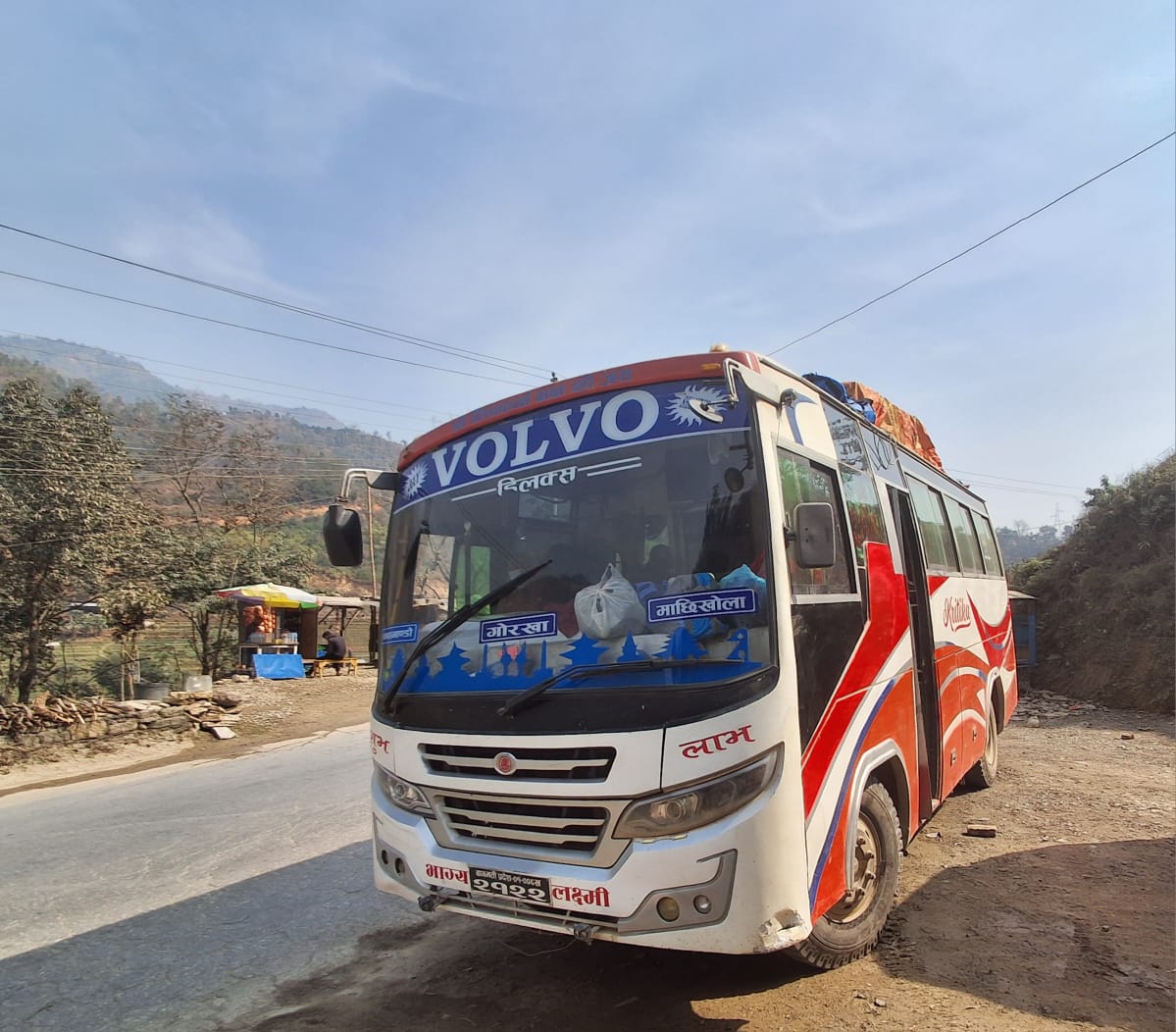
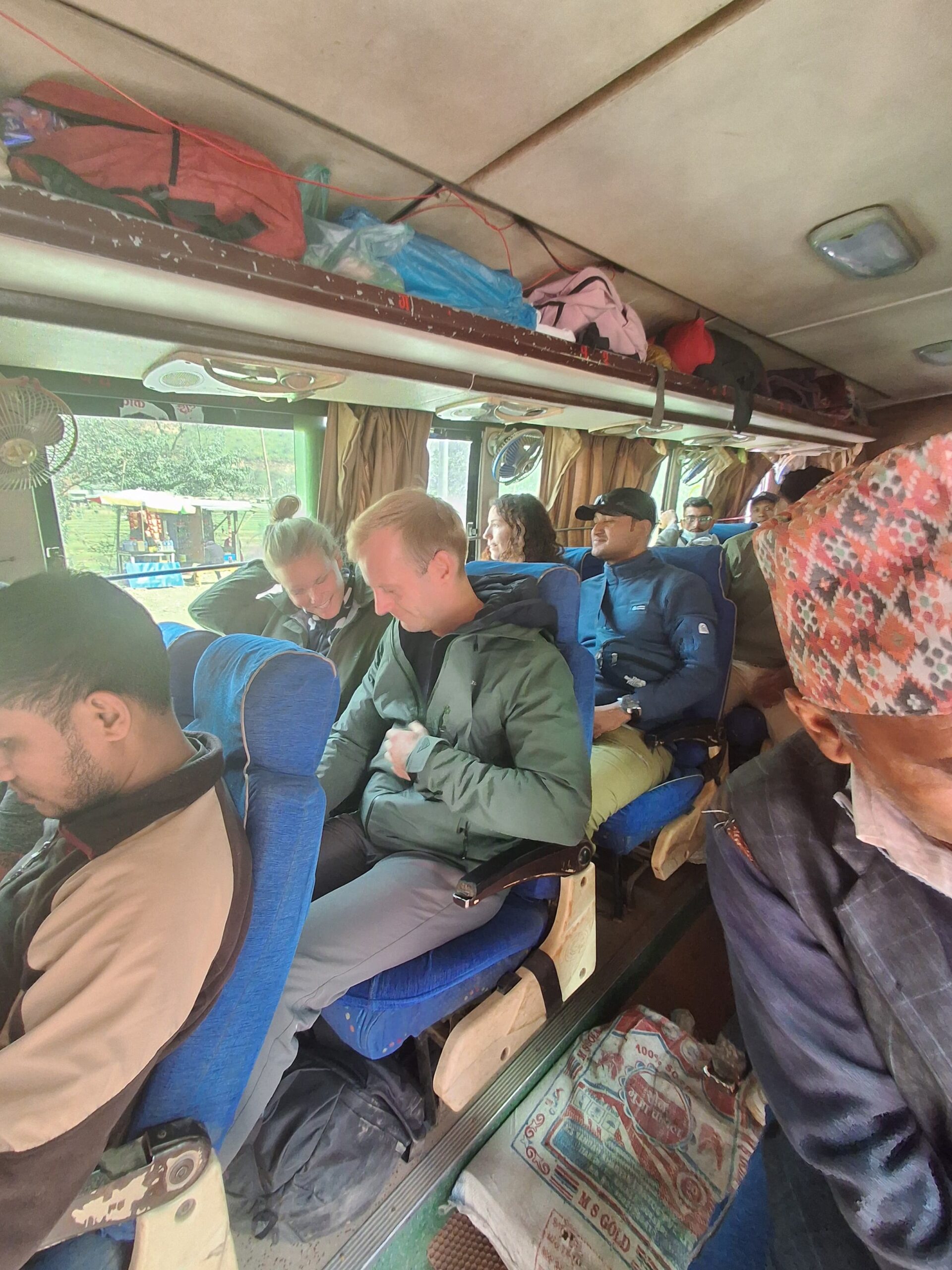
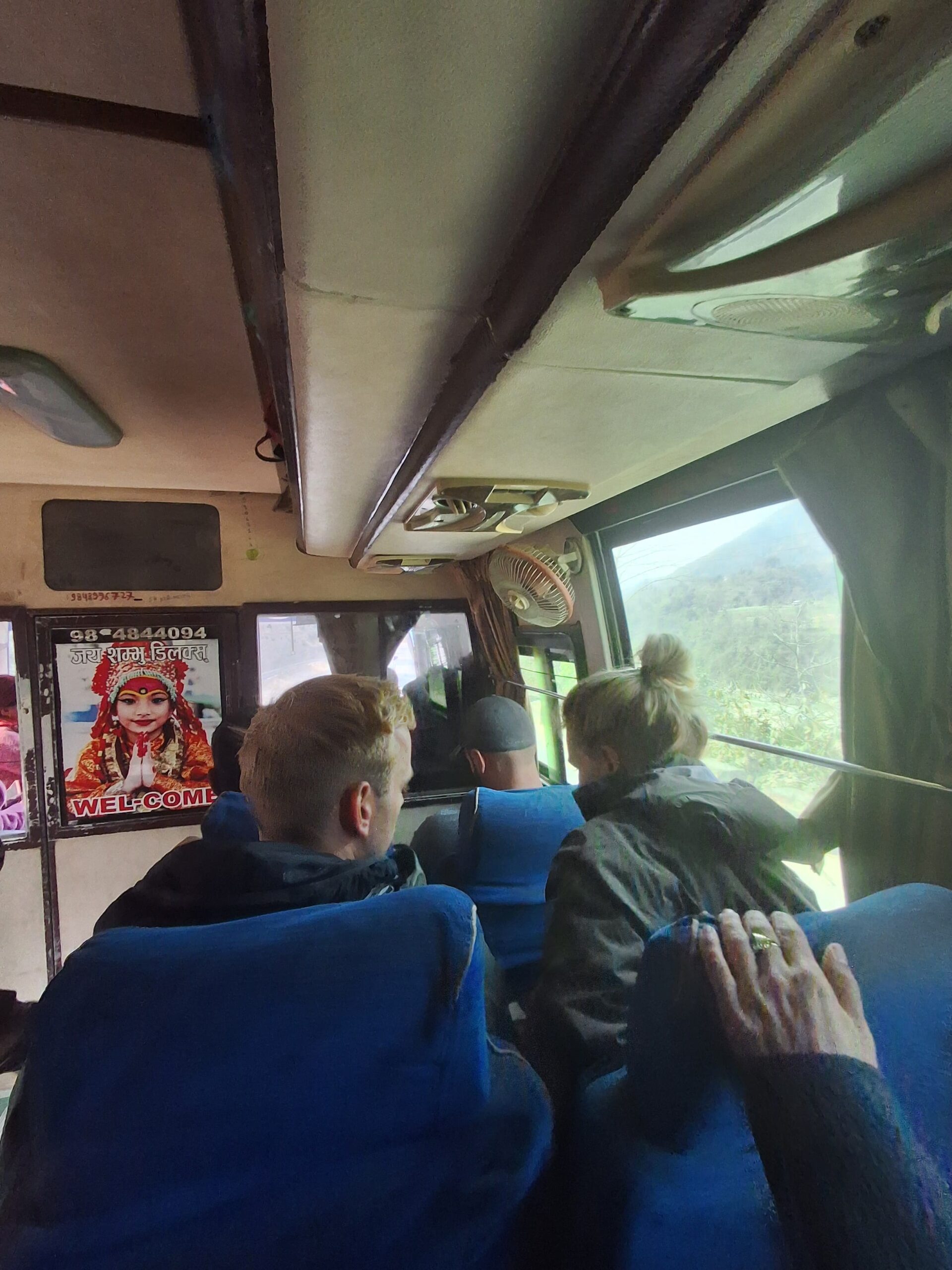
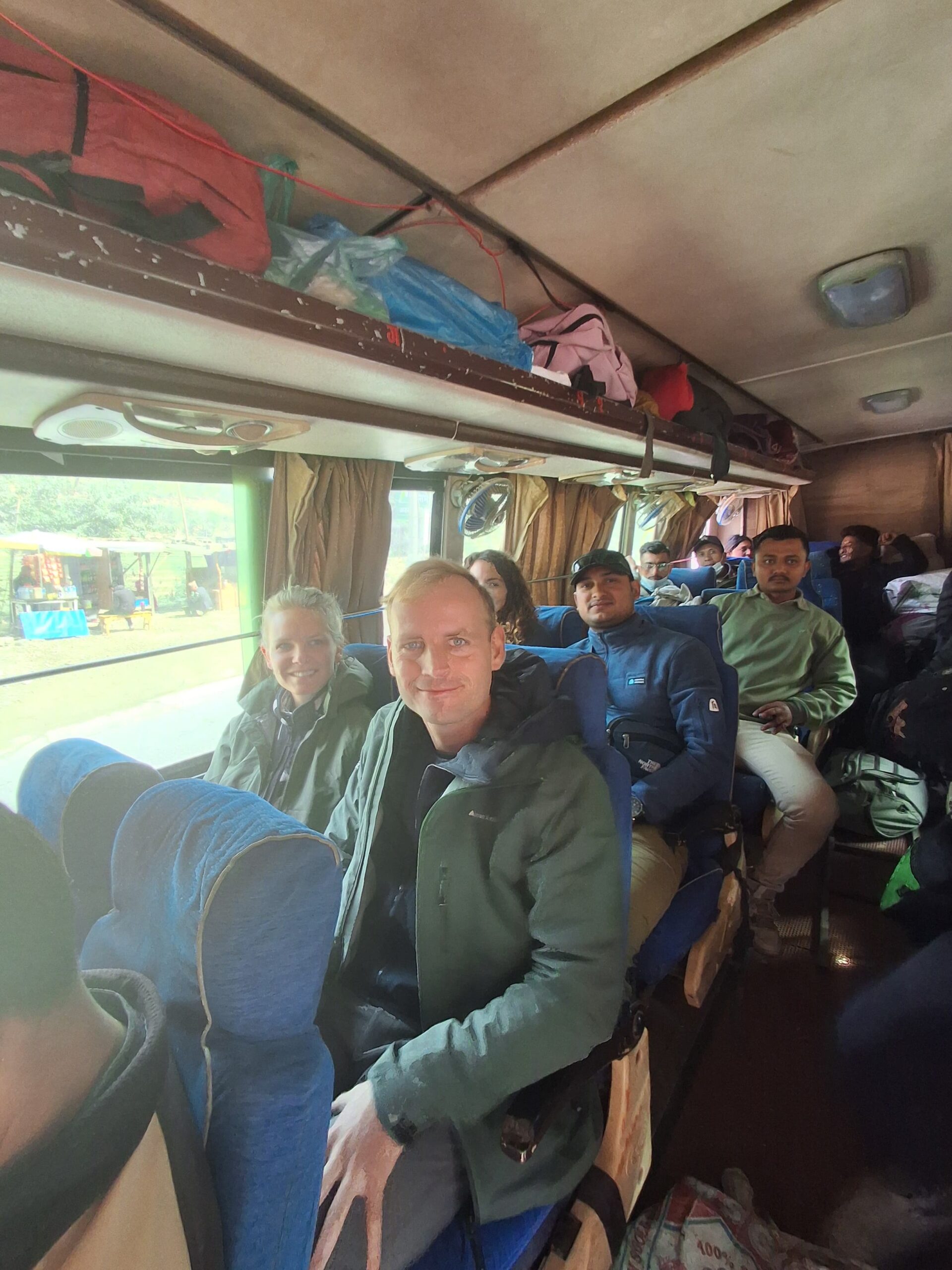
- Drive time: 8 to 9 hours
- Accommodation: Tea House
- Distance: 160 km / 99 miles
It’s an early start on the first day of your journey and excitement runs high. Even your guide will be excited, and he has experienced this trek many times before!
Just how early you need to start depends on whether you have chosen to take a public bus or a private jeep.
The buses leave the Gongabu Bus Park (around 10-15 minutes’ drive from your hotel) between 6 and 7 am. Your guide will ensure you leave you reach the bus station on time as he will accompany you in a taxi.
Although you will have confirmed tickets, it’s always good to arrive early as once the bus is full, it will just head off, regardless of schedules. By bus, it will take around 8 to 9 hours to reach Maccha Khola. The bus will stop for toilet and refreshment breaks, perhaps not in the most comfortable places by Western standards.
Should you decide to take a private jeep, the starting time is not quite as early as the jeep will come directly to your hotel around 8 am and the driving time for the lighter vehicle is shorter – approximately 7 to 8 hours.
Aside from the comfort value, the real plus of your jeep is being able to stop at better rest areas as well as for photo opportunities on the road.
The road takes us out of the Kathmandu Valley and along the highway that runs between Kathmandu and Pokhara until you turn off near the village of Dhading.
Driving through small settlements and crop terraces, the paving turns to a bumpy dirt road. The less comfortable ride is compensated by the now views of Annapurna, Langtang Himal, Ganesh Himal, and of course Manaslu.
Finally, we reach Maccha Khola where your first teahouse accommodation awaits.
Day 2: Maccha Khola to Jagat
- Trek time: 5 to 6 hours
- Accommodation: Tea House
- Distance: 14 km / 8.6 miles
This is the first day of actually hiking on this 13-day trek! With the altitude being low and the weather being comfortably warm, walking should not be too taxing. A great day to gain the rhythm of your trekking stride.
On the other side of the coin, today you will learn that in the Himalayas there is no such thing as a straight route between A and B! Plenty of ascents and descents will satisfy those who love hiking.
After breakfast at the teahouse, follow the banks of the Budhi Gandaki River, hike through a forest where monkeys and langurs live, and on to the Gurung village of Khorlabeshi. Many people in this village are shepherds and still wear a traditional cape called a Bokkhu.
For those who have not experienced crossing suspension bridges, now is your chance! Negotiate the swaying bridge over the river far below and up stone stairs to reach Doban village. Finally, the trail takes us into the village of Jagat where we enter the restricted area of the Manaslu Conservation Area.
Jagat is situated in a picturesque valley and its inhabitants are mainly Gurung and Tamang people with their traditions and language.
You will have a chance to discuss some of the local customs with your guide as you enjoy your first dinner on the trail. Like most of the teahouse lodges on this route, meals will mainly consist of Nepali food, with some international and Tibetan dishes.
Day 3: Jagat to Deng
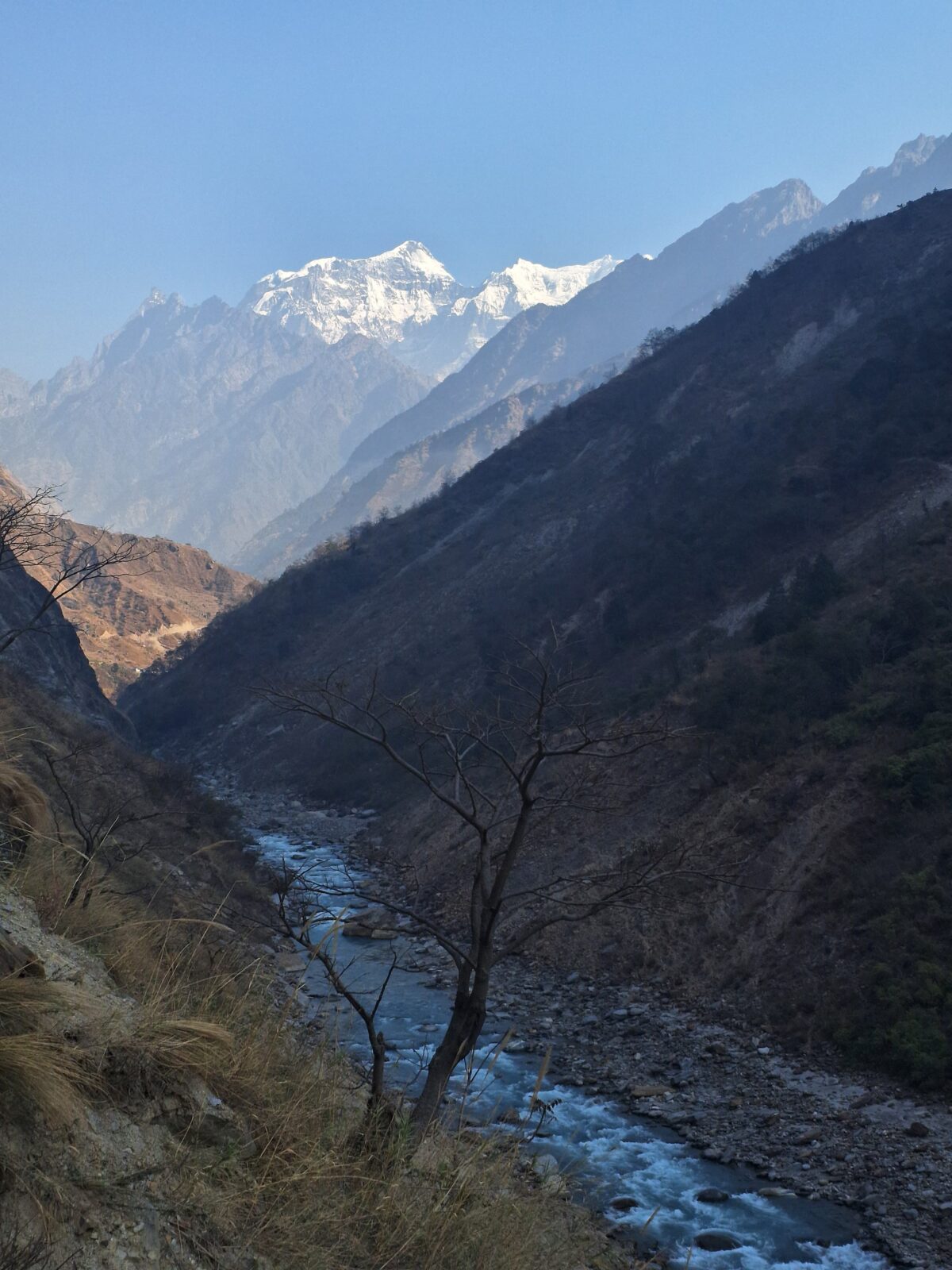
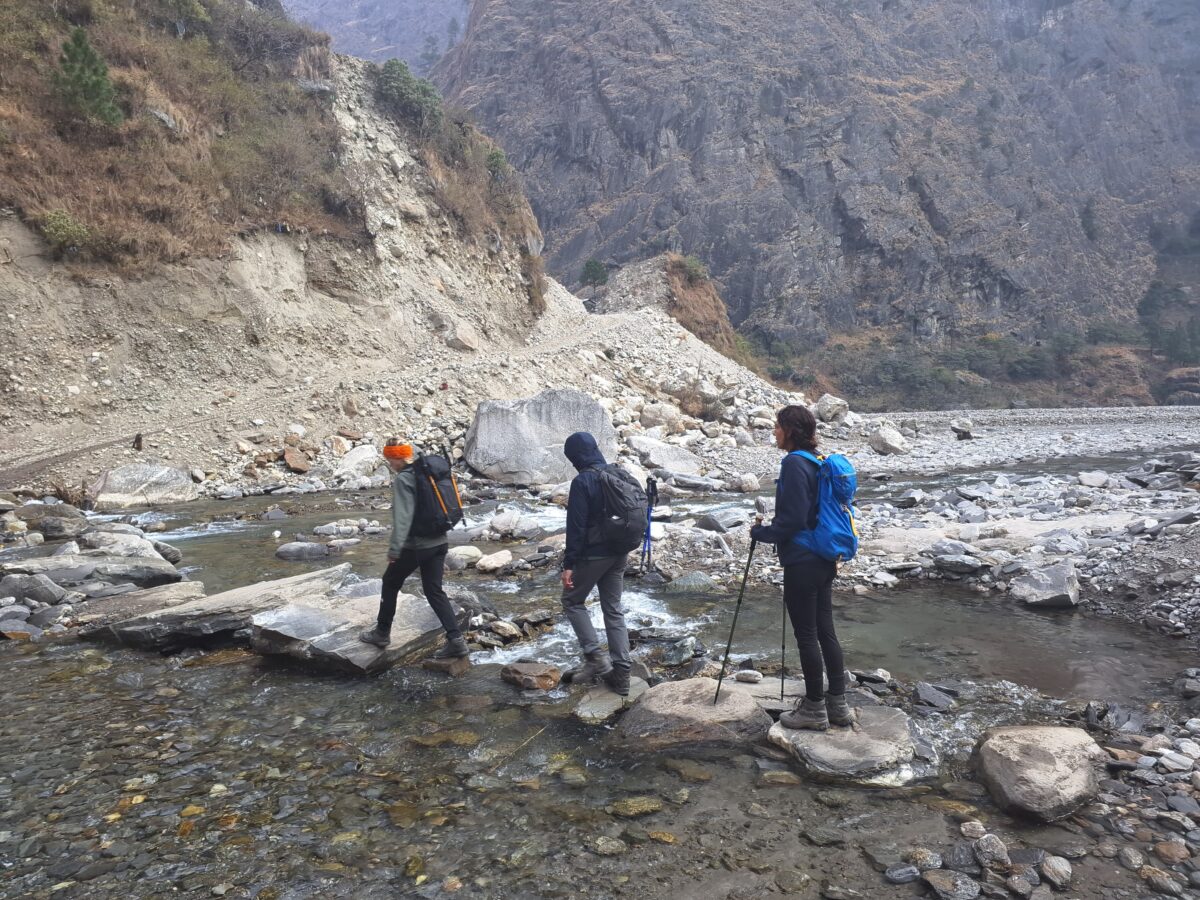
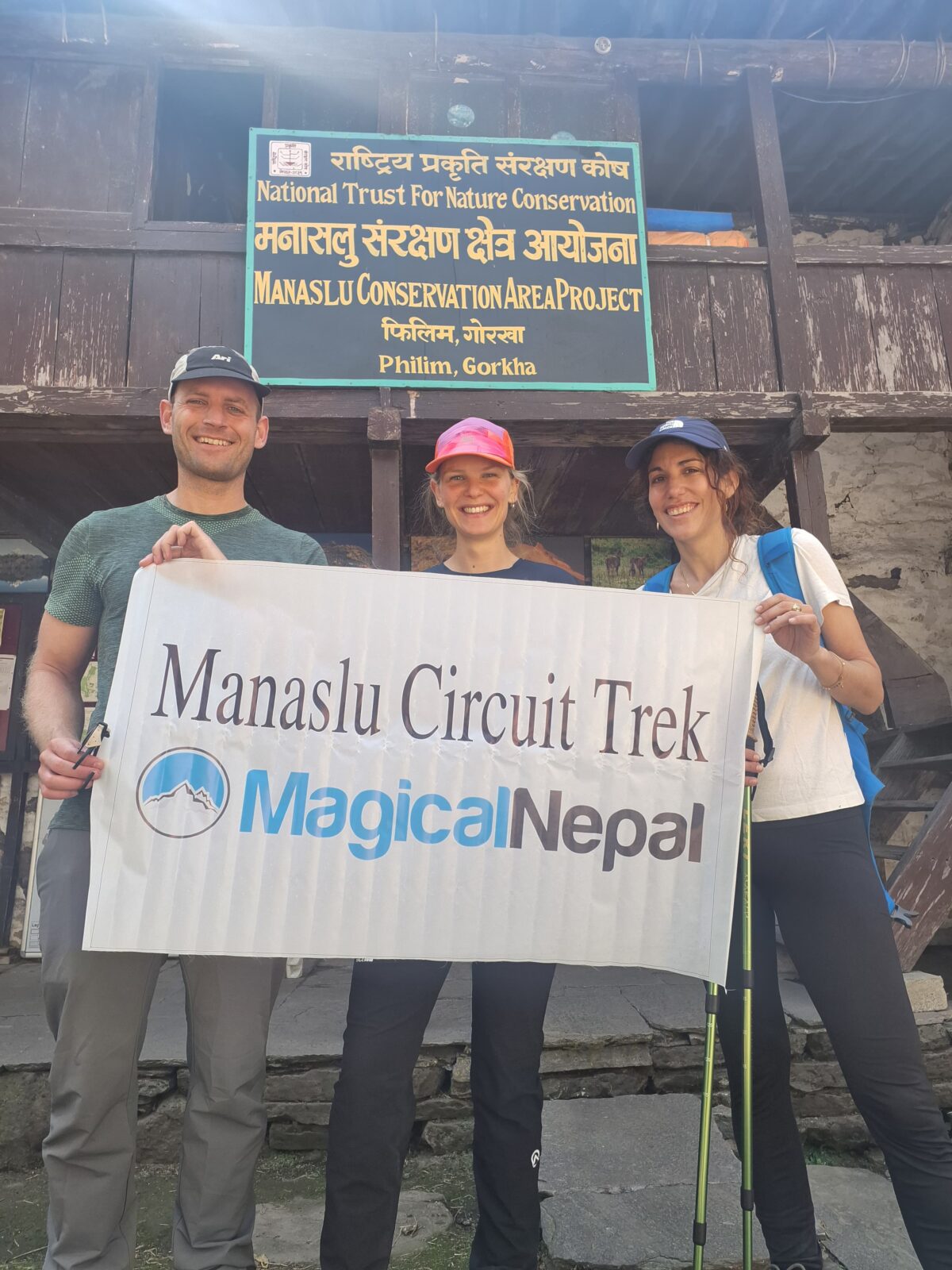
- Trek time: 5 to 6 hours
- Accommodation: Tea House
- Distance: 19.9 km / 12.3 miles
Today the trail is stunningly varied beginning with a bit of a climb over a rocky ridge to reach the village of Salleri. Naturally, there is then a descent to the village of Sirdibass. In both these villages and along the trail you will see Buddhist prayer flags and gompas (monasteries).
Crossing another suspension bridge, which, by this time, you are pretty confident on, there is a large Gurung village called Philim.
Being that there are a large number of millet fields between this village and the neighboring village of Ekle Bhatti, it will come as no surprise that there is a good amount of local alcohol available. Not that we recommend you try any; perhaps just a sip or two!
The trail enters a steep gorge and crosses the Budhi Gandaki River which you cross a couple of times again until the trail widens in the valley and bamboo forests to yet another river, the Deng Khola, which you also cross to reach the village of Deng.
One of the highlights of the day is the naturally formed, by eons of running water, boulder sculptures along the river banks. The rhododendron and Himalayan pine forests are also a feature today, along with the ever-present Himalayan mountains!
Don’t forget to ask your guide to point out the junction where the trail separates towards the Tsum Valley. This is another fascinating region that can be visited as an add-on or separate trek to this one.
Day 4: Deng to Namrung
- Trek time: 5 to 6 hours
- Accommodation: Tea House
- Distance: 20 km / 12 miles
Because the Himalayas are young, and ever-growing mountains, there is always some movement below the earth. Thus, today the trail crosses several landslide zones between Deng and Namrung. Your guide will ensure, to the best of his ability, your safety on these stretches.
The day starts with a steep climb then a descent back to the Budhi Gandaki River passing small villages and through forests and alpine vegetation.
Although you will notice more and more Tibetan influence, with Tibetan mantras carved into stones, an abundance of prayer flags, etc, Namrung is a predominantly Gurung village.
Located on a hillside, surrounded by terraced fields, alpine forests, and rhododendron bushes, this village has a very picturesque location and is noteworthy pretty itself. It is also to be noted it has some of the best teashops and teahouse lodges on this trail! We can even find WiFi here. A great place to explore and relax in before dinner.
Day 5: Namrung to Lho
- Trek time: 3 to 4 hours
- Accommodation: Tea House
- Distance: 10 km / 6 miles
As we are now climbing higher in altitude, we slow things down a bit for the next few days. But there is no ‘slowing down’ of natural beauty or culture.
In fact, from here the culture takes on a whole new look: with Nubri people in traditional Tibetan dress and fascinating Buddhist paintings on gateways, among many other things. Lho is a fascinating settlement with many Tibetan mantras carved into the village walls.
Today we walk through not just pine and rhododendron forests but also oak forests and across rocky hills with perfect views of Manaslu and Manaslu North.
How perfect is this place? The culture, the views, and plenty of time to explore the mountains, and talk and be inspired by the mountain people.
Day 6: Lho to Sama Gaun
- Trek time: 3 to 4 hours
- Accommodation: Tea House
- Distance: 9 km / 5 miles
There is a noticeable difference in the climate and in breathing as the altitude rises. There is also a culture change again.
With Mt Manaslu following us, or are we following it? it’s a relatively easy trail through pine and rhododendron forests and a moss-filled gully. It’s a short day of hiking to reach Sama Gaun where, as mentioned, the people are predominantly of the Nubri group.
Along with traditional yak pastures, this village has a big gompa (monastery) as the Nubri people also follow Tibetan Buddhism. Interestingly, there is a heliport, and WiFi access here as well as a health post; something that is so important for the surrounding local communities.
Day 7: Acclimatization Day (Day Trip to Manaslu Base Camp or Pungyen Gompa)
- Trek time: 7 hours
- Accommodation: Tea House
- Distance: 11 km / 6 miles
Just when you were getting too relaxed with the proceeding shorter days of hiking we take the opportunity to tell you that this acclimatization day is not a rest day!
The best way to acclimatize, in this case to cross the Larkya Pass and visit the Tibetan border (at around 5,000 m / 16,404 ft), is to spend the day climbing higher. The old saying ‘climb high, sleep low’ springs to mind.
But for those who are struggling with the altitude, we have a shorter option of hiking to Birendra Tal, a high-altitude lake that is only a short walk (less than 2 miles) from Sama Gaun. In around 2 hours those who choose this option can visit the lake, explore its beauty, and return to the village.
Meantime, the other, longer and highly recommended options are a walk to Pungyan Gompa or a hike to Manaslu Base Camp.
The route to Pungyan Gompa takes you through yak fields and receding trees down an exposed path to the monastery. Overall, the trip will take 5 to 6 hours and we recommend taking a packed lunch with you.
With a history dating back 400 years, this monastery is important to the Nubri people who believe in Lord Pungyen as the guardian of Mt Manaslu. Like all Tibetan Buddhist monasteries, visitors are allowed to enter to enjoy the serene peace and colorful murals within the gompa.
The hardest of these acclimatization hikes is to Manaslu Base Camp at 4,880m / 15,748 feet. Taking around 6 to 7 hours to complete, this is perhaps the best way to acclimatize to what is to come in the following days.
The rewards are the amazing panoramas of Manaslu, Sama Gaun itself, and Birendra Tal. Not to forget the wonderful high mountains of Himalchuli (7,893 meters / 25,895 feet), Ganesh Himal (7,319 meters / 24012 feet), and Shringi Himal (7,187 meters / 23,579 feet) and others.
Day 8: Sama Gaun to Samdo
- Trek time: 2 to 3 hours
- Accommodation: Tea House
- Distance: 10 km / 6 miles
This is a short day on the trail, so maybe you can convince your guide to let you spend an extra hour in bed. Or maybe not with the excitement building as you approach the main highlights of this trek.
Passing a valley of yak pastures, this is again a great time to get your binoculars out if you are a keen birdwatcher. Climbing out of the treeline, cross the Budhi Gandaki river to reach the village of White Kani with its main trade being yak herding. It’s only a short walk then onto Samdo village.
Again, the locals, members of the Bhotia community, follow Tibetan Buddhism and the village is sprinkled with Buddhist artifacts such as prayer flags and chortens.
Since it is still only lunchtime, we suggest you spend time either hiking to Samdo Peak (please consult with your guide first) or exploring the nearby villages.
Day 9: Acclimatization Day (Day Trip to Tibet Border)
- Trek time: 8 hours
- Accommodation: Tea House
- Distance: 12 km / 7 miles
As a day for rest, you will stop at Samdo where you will go for a day trip to the Tibetan border. From the border, you can also see parts of Tibet and Nepal. If lucky, you can also witness the Yak caravan passing the border.
Once at the border, if you look towards the south of Samdo Glacier you will get excellent photos with a huge serac near the top of the glacier. You can also frame Blue Sheep, Pica’s, and Marmots in season.
Day 10: Samdo to Dharmasala
- Trek time: 8 hours
- Accommodation: Tea House
- Distance: 3 km / 1 miles
Today we pass through an interesting trading post village for traders crossing from Tibet. This seasonal Tibetan market is known as Larke Bazaar and if lucky we may see some interesting negotiations going on between the traders. Passing through the village and across the Budhi Gandaki River, the trail heads up to where we can see the Larkya Glacier. On the way, there are many monasteries to photograph and admire.
Day 11: Dharmasala to Bimthang via Larkya Pass
- Trek time: 10 hours
- Accommodation: Tea House
- Distance: 18 km / 11 miles
This is the day you have been acclimatizing. A day that can be challenging and for which you need to get up early to cross before the afternoon winds. If the weather is bad it will be more difficult and yet it is exhilarating while climbing.
Tempting though it may be not to eat breakfast at 3 am, it is advisable to do so to give yourself enough energy to make it through the day. And it is also advisable to go to sleep early the night before!
The pass is 5,160m / 16,929 ft high so trekkers have to pace themselves in the high elevation. Slow and steady is the way to do this pass. Underfoot are moraines of the glacier. Everyone must walk slowly and carefully.
The views fully make up for any hardship: Himlung (7,126m/ 23,379 ft) near Tibet Kang Guru (6,981m /22,903 ft), and Annapurna II (7,937m / 26,040 ft). On the descent, there are stunning views of huge icefalls, Pongkar Tal, and Salpu Danda Glaciers.
Reaching the next teahouse accommodation at Bimthang we can feel we have done our personal best on this day and deserve some hot beverages and a great dinner.
Day 12: Bimthang to Dharapani
- Trek time: 7 hours
- Accommodation: Tea House
- Distance: 21 km / 13 miles
The final day of the Manaslu Circuit Trek brings us back down in altitude and into a warmer climate. We certainly feel the change.
Hiking downhill through pine and rhododendron forests, we note the increase in the local flora and if lucky, spot some wildlife. Crossing the Dudh Khola river, the trails take us to Karche village where we can spend some time enjoying lunch. Then it’s back onto the trail, passing signs of past glacial floods where the trail becomes rough due to earlier damage.
As the trail drops down through the valley, there are more signs of agriculture, particularly around Gurung Goa, a Gurung village. The trail also becomes easier, and trekkers can relax a bit as we hike down to Dharapani, the last overnight on the trek.
While we say it is best not to drink alcohol while trekking at altitude, on this final night it would be lovely to perhaps enjoy a beer or a local beverage!
Day 13: Dharapani to Kathmandu
- Trek time: 7 hours
- Distance: 243 km / 143 miles
After breakfast, backtrack a little to Tilije where we can take a local jeep to Beshi Sahar. From there take a local bus back to Kathmandu. Should you wish to take the more comfortable private jeep option from Beshi Sahar, please let us know before your trek, or at least a few days earlier if you suddenly find the prospect of a local bus journey less than attractive at the end of your fascinating, yet tiring trek.
Back in Kathmandu, relax in one of the many great hotels on offer. A really hot shower and a comfortable bed sounds like a great plan!
Not satisfied with this Itinerary?
Are you interested on planning custom trip? It only takes 2 minutes.
Includes
- 12 nights accommodation in mountain teahouses
- Guide for 13 days
- Kathmandu Maccha Khola, Dharapani Kathmandu Local Bus
- Manaslu & Annapurna conservation area permit
- Restricted area permit
- 13 x breakfast, 13 x lunch and 12 x dinner while on the trek
- One Porter for 13 days USD 299 (Optional)
- Private Jeep USD 440 (Optional)
- Any hot or cold drinks
Choosing the Right Gear and Equipment
There is a standard list of gear and equipment to take when trekking in Nepal. This will only really vary depending on the season and anticipated weather. And let’s not get carried away: you are not going to change your outfit every day, nor will you need anything ‘dressy’ to wear in the lodge in the evening!
Remembering that you, or a porter, has to carry whatever you decide to take with you will help you keep your bag light.
It is recommended you keep your rucksack (the one that the porter will carry if you decide to hire one) under 10kg / 22lbs. One way to test this is to try carrying a 10kg rucksack around your local park for 6 hours.
You can do that? Now carry it uphill for 6 hours with a mask on (to replicate the thinner air at altitude).
If you decide to go minimalist after this little test, there are a few items you cannot scrimp on: good, pre-worn hiking boots; warm undergarments; a warm hat and gloves; and a good pair of hiking trousers, for example.
Here is a fuller list, and note some items are only required at certain times of the year.
Clothing:
- 2 pairs of trekking trousers
- 2 warm sweaters
- 3 drip-dry shirts or T-shirts
- 2 sets of thermal underwear
- correct number of underpants/bras as per your trip
- 3 pairs of woollen socks
- 3 pairs of cotton inner socks
- sandals or similar to wear in the teahouse
- a woolen hat for the cold
- sun hat
- gloves (waterproof in the monsoon and winter seasons)
- 4 seasons sleeping bag with hood
- a thin sheet of foam rubber for a mattress (optional but it can be more comfortable)
- down jacket – useful in the mornings and evenings even in the spring and autumn
- fleece jacket for during the day or as extra warmth under the down jacket at colder times
- raincoat (during the monsoon season)
- waterproof trousers (for monsoon and winter season)
Other essential items
- sunglasses
- a good sunblock
- lip salve
- a medium-sized towel (teahouses do not provide them)
- handkerchief
- water bottle and purifying tablets
- LifeStraw (a water filter) (optional)
- day pack (which you will carry even if you hire a porter to carry the rest)
- headlamp
- candles and lighter
- phone charger/ power pack
- pocket knife
- trekking poles (even if you don’t use them on your local hikes, it’s better to have them for those difficult trail sections or extra tiring days)
Medical kit
Your guide will have a basic medical kit with him, but it is handy to carry your own also.
- any medicines you are required to take – please bring enough for the duration of the trek for a few days more in case of delays
- medicine for diarrhoea
- throat lozenges and cough drops
- eye drops
- blister pads
- bandages
- antiseptic solution and cotton
- headache tablets
- Elastoplast for cuts
- antiseptic cream
- safety pins
Toiletries
- body soap
- shampoo – small amount (although you may never wash your hair!)
- body/ face lotion
- comb
- sanitary items for women
- toilet paper (if required)
- plastic bags for any damp clothes etc
Planning Your Manaslu Adventure
Once you have decided to trek the Manaslu Circuit there are some things you need to consider to have both a safe and fabulous time.
Practical Tips for a Successful Trek
While at the booking stage, please add a couple of days to the end of your trek before you catch your international flight. Also, feel free to add more days and explore the country! But if you are short on time, do add those couple of days in case of delays. Better safe than sorry!
If you have never trekked in the Nepal Himalayas before you should remember that the Himalayas are not the Alps or the Rocky Mountains.
The mountains are higher with many of the trekking routes being at altitudes over 3,000 m / 9,842 ft. This makes for a challenge straight off.
Why? If you have never trekked at altitude you will be unaware whether you are one of the unlucky ones who struggle with altitude-related problems. And there is no way of knowing who will face problems: it doesn’t matter your age, or your level of fitness, altitude problems can strike anyone. You also may not know how exacting hiking at altitude is compared to hiking at near sea level.
Keep in mind that with few exceptions, at the end of a long day hiking in perhaps cold and damp conditions, you are not returning to a lovely skiing-type lodge with hot water in your room and central heating.
No, trekking lodges in Nepal are simple affairs. Often just two single beds in a room with perhaps a chair and table to keep your belongings on. No attached bathroom, no heating, and maybe even less than adequate bedding. Carrying your sleeping bag does come in handy!
Food too may be unfamiliar, although these days the majority of lodges, known as teahouses, have some international cuisine on the menu such as pasta, noodles, soups, and breakfast varieties.
If you can get your mind around these things you are halfway to having a wonderful trek!
On the physical side, you should prepare well in advance for your trek through targeted exercises. Hiking and hiking uphill are a good place to start as is building muscle at your local or home gym.
Getting to know your trekking company and trekking guide in advance will give you more confidence on the trail. Ask any questions by email and once you arrive in Nepal, be open to a pre-trek meeting with your guide.
Consider whether you require a porter or not. This can make or break your trek. If you are experienced at trekking while carrying your full pack, then you can make an informed decision.
If you are a novice trekker or new to trekking at altitude, we suggest a porter will make life a whole lot easier and more enjoyable. Note that each porter can carry two client packs up to a total weight of 20 kg / 44 lbs. That is 10kg / 22 lbs per person.
So, the cost of a porter can be shared between two trekkers. Should you think you will require a porter to carry more than 10kg we suggest you hire one for yourself alone. Please talk to us about the cost of a porter.
As well as a good sleeping bag (which you can also hire in Kathmandu on arrival), there is a list of gear you should bring for your trek to ensure you have a warm, comfortable time. Great, pre-worn trekking boots come instantly to mind.
Depending on the time of year, the weather may impact what you pack to bring with you.
Do not expect to find an ATM on the majority of trekking trails! Please change money on arrival in Kathmandu and carry local currency with you for those extra items such as drinks, snacks, donations at monasteries (optional), tipping the guide, and any souvenirs you may spot on the way.
You can calculate in the USD 20 per day range (excluding any tips for the guide).
This depends on how many soft drinks and beer you plan to consume. As a rough guide: a bottle of water (when available) or soft drinks can cost USD2-5. Beer costs USD 5-8.
Don’t forget you will also be charged (around USD 3-5) for a hot shower, and around the same for charging your gadget.
Seasonal Considerations and Weather Patterns
You will read that the best times to visit Nepal are March/ April and October/ November/ December. This is quite true, but there are some benefits to visiting at other times too.
There are varying climates in the different trekking regions. For example, the monsoon brings rain from July to late September making many trails slippery and bringing out the leeches and clouds. Yet some locations are in the rain shadow and are not affected by these things.
The Manaslu Circuit Trek is at its best during the spring and autumn seasons, and being a restricted area does not see the same number of trekkers in any season as other trails. This is a big advantage: while the more popular trekking routes are overcrowded, with accommodation sometimes hard to find, Manaslu does not have these problems.
Not having to fly in and out of the region also is a positive! No delays due to bad weather grounding your flight! However, even with no flight to rely on, most trekkers, unless very seasoned and prepared, do not wish to trek in the winter months due to the cold, snow, and possible pass and route closures due to snow and ice.
The time of year you choose will also influence what flora and fauna you are likely to experience. It also influences your cultural experience. In the winter, many locals vacate the mountains for less harsh environments, closing down some of the teahouses they run. On the other hand, timing your trek with local festivals will enrich your cultural experience.
Breakdown of the best times to visit:
Spring (March to the end of April) and autumn (September to the end of November) have the clearest skies and relatively reliable weather. In the spring the rhododendrons will be in bloom making the trails bright with color. In the autumn the weather will be cooling off as it heads towards winter but at lower altitudes it is still fine and sunny. In the autumn the monsoon will have washed everything clean and the mountains will be clear.
For experienced trekkers, the monsoon (June to August) may appeal but keep in mind the rainfall and trail conditions.
Similarly, experienced trekkers may welcome the crispness of the winter season and the possibility of hiking through snow. The route will likely have to change this season, and you should plan and book well ahead. And talk to us first before making your final decision.
Trekking Logistics and Preparation
We at Magical Nepal will make all the necessary logistical plans such as ensuring you have the best guide for the area you are trekking in; ensuring the correct number of porters (if requested by clients); ensuring transport is organized and booked; ensuring teahouses know when and how many of you are coming; trying as far as possible to have like-minded, liked-aged trekkers in your group; checking daily while on the trail that no path has been recently blocked requiring a detour, etc, there are some logistics and preparations that you, the trekker, need to arrange or confirm for yourself.
First off is your international flight and visa for Nepal.
International flights – keep in mind you might want a few days ahead of your trek to explore Kathmandu and also keep in mind, depending on the length of your flight journey, you might want a full day to rest and recover before setting out on your adventure. This might seem a small consideration when you are booking your flight and trek, but it will make a huge difference to your overall enjoyment. Additionally, do not book your international outward flight for the day you are expecting to return from your trek. Preferably not for the next day either! Delays are not unusual in Nepal, so it is good to give yourself some breathing space just in case.
Visa – tourists are entitled to stay a maximum of five months in a year. Visas are available online and at the airport. Obtaining your visa online still involves you paying and getting the actual stamp on arrival at the airport in Kathmandu. But is a quicker process if you fill in the necessary visa forms online and print them out to bring with you. You can apply for your visa online not more than 15 days ahead of your arrival date. If you are lucky enough to live near to where at Nepal Embassy is located in your country, it is worth checking out the process to obtain the visa through the embassy in advance of your travel.
Payment of visa – do not rely on the ATM at the airport or your credit card! Bring cash dollars (don’t expect change so bring the correct amount) to make payment at the airport.
Duration of visa – you can obtain a 15-day, 30-day, and 3-month visa at the airport. These can be extended at the Immigration Office. We can recommend that if you are staying more than 15 days but less than 30, you still purchase the 30-day visa at the airport. The savings you make on the time and hassle of visiting the Immigration Office to extend your 15-day visa (within that same 15 days) is well worth the extra dollars!
Currently, in Spring 2024, the cost of a visa on arrival is:
15 Days – 30 USD
30 Days – 50 USD
90 Days – 125 USD
*Please note that Indian citizens do not need a visa to enter Nepal.
*All children under 10 (except from the USA) are entitled to a gratis visa.
Passport: Your passport must be valid for 6 months after your departure date. There should be at least two empty pages.
**Your visa for Nepal is NOT a trekking permit! That is a whole different paper and procedure!**
Insurance is important.
When purchasing your insurance for Nepal, please ensure it is valid for trekking and valid for trekking up to 5,000 meters / 16,404 feet.
Preparing physically for your trek – ideally starting at least 6 months beforehand.
Whether you book your trek well in advance or if you have a last-minute call to the mountains, you should prepare yourself physically before arriving in Nepal.
Even those who regularly visit the gym should adapt their routine to fit the conditions on the trek.
That means increased cardio workout (for the high altitude), strengthening leg muscles (for those long days on the trails), and practicing hiking (preferably uphill) with 4 or 5kg on your back.
The latter is often forgotten, particularly by novice trekkers. You will want to carry your water bottle, sunscreen, medicines, camera, and other essentials with you and the weight of these things adds up as the day goes on.
Practice and see what is a realistic weight for you to carry! If you are not hiring a porter, then practice with the weight of your full kit.
For those who are not experienced at trekking, or it’s been a while, or are of a certain age, extra care should be taken when tailoring a fitness routine towards trekking at altitude in Nepal. There may be some who require guidance from their doctor or physiotherapist.
What to pack for your Manaslu Circuit Trek.
See the Choosing the Right Gear and Equipment section for a list of essential gear to bring with you. Warm clothing you can layer, sun protection, a small medical kit, items such as a camera and headtorch, and, most importantly, pre-worn trekking boots or shoes.
Arrival in Kathmandu – what happens now?
Depending on your plans you will either be met at the airport by our representative or make your way to your hotel.
We can help you choose a good hotel if you so wish. Whether you are arriving earlier to do sightseeing or to visit another area of the country, or are arriving just before your trek, you will have the opportunity to meet your guide and talk with us.
We can answer any questions you may have and point you toward things such as hiring a sleeping bag locally, information on great restaurants, or arranging a sightseeing tour of the Kathmandu Valley.
Take the opportunity to explore the neighborhood and relax a bit in your hotel before the challenges (and rewards) are ahead!
With regards to trekking permits please check out the costs here. We will take care of all the arrangements for the permits on your behalf.
The big day has arrived, and you are off on your trek!
You will be collected from your hotel in the early morning. If you have decided to take a local bus to the starting point of the trek, you will be collected around 5.30 am by taxi and you and your guide will drive to the bus station.
If you are hiring a private jeep, the jeep will pick you up around 8 am from your hotel.
We suggest you have breakfast before leaving or, in the case of the very early morning start, bring something with you to keep you going for the first few hours of your journey.
Accommodation and food on the trek
This is a remote area trek therefore accommodation is more basic than on those busier, long-established trekking routes.
Accommodation is much as it was in the past throughout Nepal – simple rooms with two single beds, shared toilets and bathrooms, often outside the building, and heating only in the dining room. Bringing your sleeping bag will make you feel more comfortable.
WiFi is only available in some villages, as is electricity. You will have to pay to charge any appliances i.e. phone, and for WiFi. It’s a good idea to let those at home know you are likely to be offline for a few days.
Menu choices in some teahouses will be limited. A sample menu is something like this:
Safety Tips and Altitude Considerations
Is it safe to trek in Nepal?
The answer is basically, yes.
But it’s not always that simple. Accidents do happen. But avoidable accidents can be, well, avoided.
How to avoid accidents while trekking – especially the avoidable ones
The first rule of trekking in any country is Never Trek Alone. This is even more important in a country or area where you are unfamiliar with the language and lay of the land. Many people enjoy the adventure and solitude of hiking alone.
And that is fine. Up to a point. These are the Himalayas where every year we hear of extremely experienced climbers and trekkers encountering serious difficulties on the mountains.
But do not let this put you off coming! Life is an adventure; trekking is an adventure and there ARE ways to reduce the likelihood of avoidable accidents.
Going back to that first rule of never trekking alone, the Government of Nepal recently introduced a policy that foreign nationals cannot trek in Nepal without a properly registered trekking guide.
This is to ensure the safety of trekkers and it also helps them with things like calling ahead for that night’s accommodation, making the right decision at a fork in the trail, etc. It also increases their interaction with locals and greatly enhances their overall enjoyment of the trek.
The second rule of trekking is to be prepared! Increase your fitness level, bring the right gear with you, purchase insurance, and choose the correct trekking company!
The third rule is: expect the unexpected! Even those avoidable types of accidents and incidences can happen unexpectedly.
This writer recalls stumbling over a fallen tree and pulling a ligament while on a day hike. With friends and vehicles nearby, it was easy to get to the local hospital.
Imagine the same, extremely simple accident at 4,000m / 13,123 feet up and 7 hours from the lodge, never mind being days from a hospital, and without anyone there to help.
Knowing the terrain is key to a successful trek. Do your homework to see what the trails will be like at the time you are planning to visit. Will there be snow? Is there the possibility of the pass being closed? Here is where your guide excels. He knows the terrain, can spot when things have changed, and can ask the teahouse owner and locals if the trails have shifted.
Unavoidable difficulties and dangers
It is fair to say there are always dangers in the mountains. The avoidable and the unavoidable. Among the unavoidable are changeable weather conditions, avalanches, and landslides.
Weather – Choose the time of your trek with care. Spring and autumn are the best times for the Manaslu Circuit Trek in terms of clear views, and good weather. If you are planning to come during the monsoon season or in the winter, be prepared for unpredictable weather. Aside from carrying the correct snow/rain-proof clothing, it may be necessary to change your route or itinerary at the last minute.
Be prepared. Follow the advice of your guide and do not try to stick to the schedule if there are reasons not to.
Your guide will advise you to seek shelter if a storm is coming in or if it is not possible to start that morning because of heavy snowfall. He too will be checking in with locals who are more knowledgeable about the surroundings.
Avalanches and landslides are a danger in the mountains. The first is in snow areas, the second is more common around areas that have loose rocks or moraine. There are landslide-prone areas to cross and here again, your guide is invaluable to help you across safely. If rocks do begin to fall, protect your head. Avalanches can happen, and if it does, you want to try and stay as near the surface of the snow as possible. Try kicking your feet and arms as if you are swimming as you are carried downhill. If possible lie on your back while doing this. Try not to panic.
You are more likely to encounter an avalanche on a skiing holiday than trekking in Nepal, but you should be aware that nature is unpredictable.
Transport/ road problems: there may be unavoidable delays on the road if there is a landslide or a political strike. Another good reason not to book your onward flight immediately after the planned return date to Kathmandu.
Altitude Sickness
Altitude-related problems are common on high-altitude treks in Nepal. Having said that, not all altitude problems become serious or even stop you from continuing on your trek. The key here is to pay attention to your body and take the necessary steps to correct any signs of sickness.
What is altitude and why should we worry about it?
Altitude means height or elevation. It is shown in meters or feet from sea level. The reason sea level is taken as the way to measure altitude is that generally, all the oceans in the world lie at the same level.
Altitude is divided into the following levels:
- High altitude is generally accepted to be above 2,500m / 8,202 ft.
- Very high altitude comes in at 2,500m / 8,202 ft to around 5,500m / 18,044 feet
- Extreme altitude is above 5,500m / 18,044 feet
It should be noted that in Nepal many trekking companies and individuals see high altitude as happening 3,000 to 3,500m / 9,842 ft to 11,482 ft and over and it is only at this height that tell their clients to be alert for health problems. The reason for this is likely that in the Nepali mountains, a lot of settlements lie above 3,000m therefore 2,500m is not seen as particularly ‘high’.
We can be relatively confident that the average healthy person will feel no effects of altitude below 2,500m / 8,202 feet. Having said that, many people when flying into Kathmandu, which lies at 1,400m / 4,593 feet, do feel a little something if they are coming in from somewhere much closer to sea level.
To put it into context, the highest ‘mountain’ in the UK is Ben Nevis in Scotland at under 1,400m / 4,593 ft! The effects of arriving in Nepal from sea level do not last long, and most visitors put this down to jetlag rather than altitude!
We can also be relatively confident that at extreme altitudes, over 5,500m / 18,044 feet, the majority of us will have some side effects.
It is in that middle range – 2,500m / 8,202 ft to around 5,500m / 18,044 feet – that we need to take particular care of. Care because sometimes it can be difficult to recognize when there is a problem and when the problem is becoming serious.
What are the stages of mountain illnesses or AMS (acute mountain sickness)?
Often AMS starts with a headache, feeling nauseated or vomiting, and feeling tired. It can be said it feels a bit like a bad hangover (another reason not to drink alcohol on a trek).
If this happens it is best to slow down, drink plenty of fluids, and get plenty of sleep. If the feeling persists the next day, it is sensible to go down in altitude and sleep overnight at a lower level.
High Altitude Cerebral Edema (HACE) is life-threatening and is recognizable by being unable to walk straight and changes in the person’s mentality – they become confused or lethargic. This is due to a swelling in the brain. Sadly, at this stage, the person may not recognize their symptoms due to their confused state. The guide will advise them what to do and insist they do it. Another reason not to travel alone. Here you MUST go down in elevation.
High Altitude Pulmonary Edema (HAPE) is a life-threatening emergency. Fluid collects in the lungs and there is difficulty breathing. The person will need help in going down to a lower elevation and may require medical attention.
Should it be difficult to descend, a Gamow bag, which is a chamber to simulate lower altitudes, can be used while waiting for evacuation.
How can we prevent altitude-related problems?
By taking it slow and ascending gradually the risks can be reduced. This gives the body time to acclimatize to the altitude. It also gives time to check if there are any signs of illness.
The advantage of the Manaslu Circuit Trek is that it starts at a low altitude, giving bodies a chance to adjust, and there are two acclimatization days built in.
Many people would find it extremely difficult to suddenly arrive at a high altitude. For example, flying into Lhasa, Tibet (3,490 m / 11,450 ft) puts strain on a person.
Avoid drinking alcohol on the trek which can hide the symptoms. If you are required to take prescribed sedatives please be extra aware of your body, as they can mask symptoms also.
It is worth mentioning that altitude sickness is not seen only in older or less fit people. It can affect anyone of any age and fitness. Those who are young, fit, and gungho are more likely to suffer some effects as they power up the mountain.
Are there any altitude sickness medications?
Yes, there are. We suggest you discuss this with your doctor or travel center before leaving home as these medicines can interact with other medicines you may be taking regularly, so best to check rather than self-medicate.
The best medicine of all is to go slowly and steadily and stay hydrated and well-rested!
Navigating Permit Requirements
In 2023 the Government of Nepal announced that trekkers must be accompanied by a legally registered and qualified local guide. This did not impact on the Manaslu Circuit Trek as a trekking guide was always required for this restricted area.
There remains the provision that there must be a minimum of two trekkers for each group in a restricted area and that various special entry permits are required. These permits are only available through a registered trekking company.
A total of three (3) different permits are required for this trek. Should you decide to add on the Tsum Valley a fourth is required.
These permits are:
Restricted Area Permit for Manaslu (Manaslu RAP)
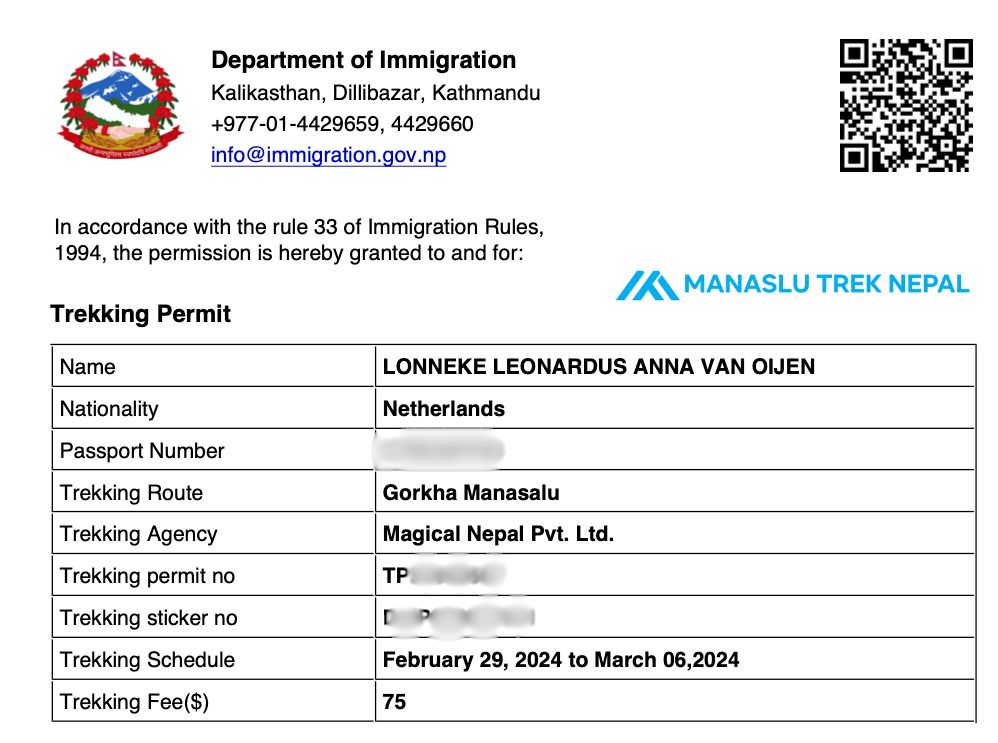
The restricted area falls between Jagat until you leave Sama Gaun; Day 3 to Day 8 on the trek. There are checkposts on the way to ensure you have this, and other permits.
Manaslu Conservation Area Project (MCAP Permit)
All conservation areas in Nepal need a special permit to enter. This permit is required from the village of Philm.
Annapurna Conservation Area Project (ACAP Permit)
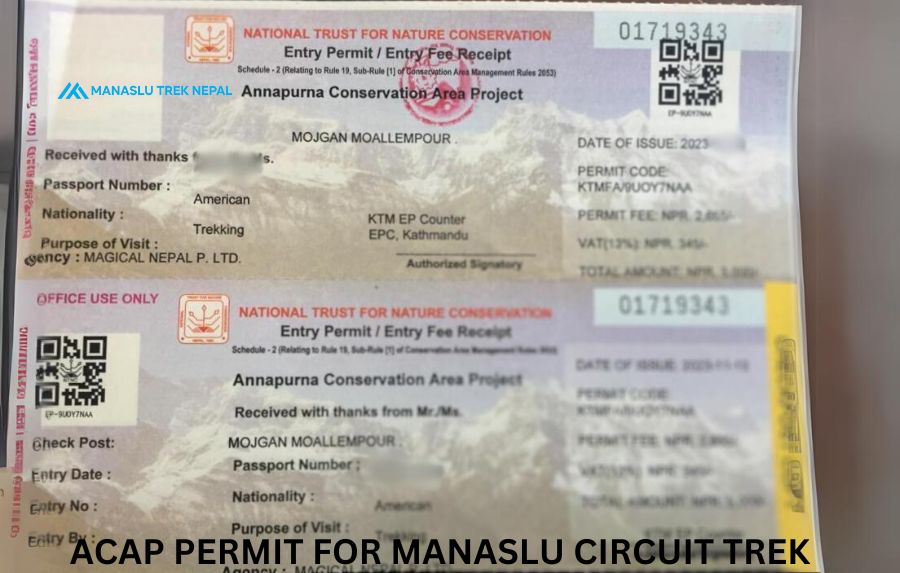
You will also be touching the Annapurna Conservation Area on this trek. Therefore, you are required to obtain a permit for this area.
How much do the permits cost?
Each permit has a different price, as below:
Manaslu Restricted Area Permit
September to November: USD 100 per person for the first seven days and an additional USD 15 per person per day from the eighth day onwards.
December to August: USD 75 per person for the first seven days and an additional USD 10 per person per day from the eighth day onwards.
Photograph: a physical photograph is unnecessary, but your photo will be uploaded.
Manaslu Conservation Area Project (MCAP Permit)
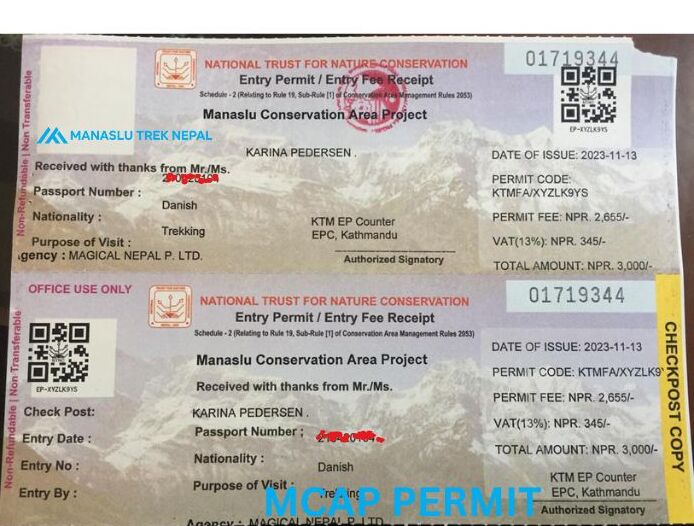
USD 30 per person, for the duration of your trek, regardless of the month.
Annapurna Conservation Area Project (ACAP Permit)
USD 30 per person, for the duration of your trek, regardless of the month but valid for one single entry only.
Tsum Valley Restricted Area Permit (RAP)
If you intend to extend your trip into the Tsum Valley you will require an additional permit.
The cost of this permit is USD 40 per person for the first week and USD 7 per additional day from September to the end of November. From December to the end of August, the cost is USD 30 for the first week and USD 7 per additional day.
Please note if you are trekking only in the Tsum Valley you will still require the other permits as mentioned above.
*If you have trekked in Nepal in the past you may have required a TIMS card (Trekkers Information Management System) at that time. These are no longer required on any trek.
How do I get all these permits?
We at Magical Nepal will organize these for you once you arrive in Kathmandu and before you head out for your trek. Please note the cost of the permits is NOT included in the cost of your trip. You should pay directly to us when you arrive in Nepal.
Exploring Side Trails and Optional Excursions
Manaslu Circuit Trek with Tsum Valley
The Manaslu region is an amazing remote area trek so why not extend your time in this wonderful land of high mountains, wilderness, fascinating culture, and unique wildlife and enter into an even more pristine and remote area: the Tsum Valley?
Exploring the Tsum Valley as part of the Manaslu Circuit Trek adds another seven exciting days to your journey. It takes you deeper into the land of monasteries, Chortens, gompas, and Tibetan Buddhism and into a land that only opened to foreign trekkers in 1990.
Just when you thought the Manaslu Circuit Trek couldn’t get more exciting – it does! From Day 3 on this trek, you head into the hidden valley of Tsum where the people are even more closely related to Tibetans in culture and religion. On Day 11 you rejoin the regular Manaslu Circuit Trek until you leave the area on Day 20.
This extension of your trek is an exciting and at times jaw-dropping voyage. But make no mistake, it is a demanding trek, with long days, and several days hiking at over 3,000 meters / 9,842 feet. If you feel you have the level of fitness required for this exacting trek here is what you can expect in addition to many of the sights on the main part of the Manaslu Circuit Trek:
- Thundering waterfalls and fast-flowing rivers to Gurung villages with their terraces of rice and millet.
- Demanding rocky trails and swaying suspension bridges.
- Tibetan mani (prayer) walls, shrines, gompas (monasteries), and scarlet-robed monks and lamas.
- Explore Mu Gompa, the largest monastery in the region.
- Fascinating views of Manaslu, Ganesh Himal, Hiunchuli, and Larke Peak.
- Several unique glaciers to wonder at.
- Explore the secret hidden valleys and climb the high pass at Larkya.
- Get close up to the Tibetan border.
Tsum Valley
For those who are particularly interested in the Tsum Valley but have less than 20 days to spend on the trek, it is possible to trek the Tsum Valley without the Manaslu Circuit Trek itinerary days. The Tsum Valley Trek can be completed in 14 days.
- Satisfied Client
- Personalised Guide
- Instant Response
Get Instant Response:
+977-9851329446 (Whatsapp)
